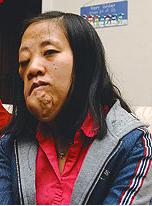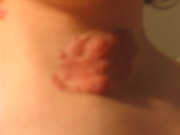Bilateral paralysis of the diaphragm is either idiopathic or associated with several medical conditions, including trauma or thoracic surgery, viral infections, and neurologic congenital or degenerative disorders. We describe the case of a 36-year-old man with a history of neurofibromatosis who developed severe bilateral diaphragmatic paralysis from involvement of the phrenic nerve roots with neurofibromas. The patient manifested progressive exertional dyspnea and debilitating orthopnea requiring the use of noninvasive mechanical ventilation at night. A review of the literature reveals that neurofibromatosis is an unrecognized cause of diaphragmatic paralysis.
(CHEST 2000; 117:1196-1199)
Key words: diaphragm dysfunction; neurofibromatosis; phrenic nerve; respiratory failure
While unilateral diaphragm paralysis is of little clinical significance unless there is underlying respiratory disease, bilateral dysfunction of the diaphragm can cause various degrees of respiratory dysfunction.[1] In the latter case, the symptoms include exertional dyspnea, when bilateral weakness is present, or severe orthopnea and hypercapnic respiratory failure in bilateral diaphragm paralysis.[1] Several causes of bilateral diaphragmatic paralysis have been described, including congenital muscular (eg, muscular dystrophy) or neurologic (eg, Arnold-Chiari malformation and syringomyelia) disorders; various degenerative (eg, multiple sclerosis) and viral (eg, herpetic) diseases; traumatic involvement of the phrenic nerves (surgical section or thermal injury); and idiopathic causes. However, involvement of the phrenic nerves or their roots by neurofibromas, as described in the present case, is not a recognized cause of bilateral diaphragm paralysis.
CASE REPORT
A 36-year-old man was referred to the pulmonary clinic for evaluation of a right upper lobe mass. His medical history was remarkable for neurofibromatosis that had been present since age 15, with multiple neurofibromas involving the skin and a malignant neurofibrosarcoma that had been removed from his left leg without complications about 15 years prior to his initial visit to our clinic. The patient had a distant 3-pack-year smoking history and had been abstinent for [is greater than] 10 years. He had been completely asymptomatic from a pulmonary standpoint, except for recent exertional dyspnea. A chest roentgenogram, ordered because of right upper chest and right shoulder discomfort, revealed a round and well-defined right apical chest mass (Fig 1). A chest CT scan confirmed the presence of a rounded mass measuring 5 cm in diameter and located in the right apical paravertebral region (Fig 2). There was no evidence of other masses along the known anatomic paths of the phrenic nerves.[2,3] The findings were compatible with a neurofibroma, considering the patient's known history of neurofibromatosis. The clinical diagnosis was confirmed by surgical resection of the tumor, which was done without complication in June of 1995. One month later, another neurofibroma was removed from the right brachial plexus. The surgery was complicated by severe dyspnea, and particularly orthopnea, in the postoperative period immediately following extubation. Dyspnea improved within a few hours postextubation; however, persistence of orthopnea after discharge from the hospital prompted a second visit to the pulmonary clinic.
[Figures 1-2 ILLUSTRATION OMITTED]
On examination, there was evidence of severe diaphragmatic dysfunction with dullness at the bases of the lungs, diminished excursion of the diaphragm, and marked paradoxical inward motion of the anterior abdominal wall on deep inspiration. In addition, the patient was unable to remain in the supine position for more than a few seconds because of severe dyspnea. He claimed that he had been forced to sleep in an upright position for several weeks. A workup was undertaken to confirm the clinical suspicion of bilateral diaphragmatic paralysis. Spirometry and lung volumes revealed a moderately severe restrictive pattern, with FVC of 2.32 L (48% of predicted value) in the upright position and 1.51 L (31% predicted) in the supine position. [FEV.sub.1] was 1.69 L and 0.86 L in the upright and supine positions, respectively. Maximal inspiratory and expiratory forces were -61 (58% predicted) and +84 (42% predicted) cm [H.sub.2]O pressure, respectively, confirming severe respiratory muscle dysfunction. Transdiaphragmatic pressure, assessed by esophageal and gastric balloon pressure monitoring, revealed a significantly decreased pressure of 31 cm [H.sub.2]O. Fluoroscopic examination of the diaphragm (the "sniff test") revealed marked decrease in diaphragm motion bilaterally. Electromyographic studies of the diaphragm after stimulation of the phrenic nerves on both sides revealed no response. MRI of the cervical spine, obtained for a complaint of arm pain and paresthesias 4 months prior to the development of dyspnea, had revealed enlargement of the nerve roots within and lateral to the neural foramen at the levels of C3-4 and C6-7 on the right, and bilaterally at the levels of C4-5 and C5-6, most consistent with multiple neurofibromas (Fig 3). In summary, the radiographic, physiologic, and electrophysiologic studies were all consistent with severe bilateral diaphragm paralysis, which was believed to be secondary to involvement of the phrenic nerve roots (C3 to C5) with neurofibromas. For the past 3 years, the patient has been able to sleep flat at night with the assistance of noninvasive ventilation (bilevel pressure ventilation), and exertional dyspnea has remained stable.
[Figure 3 ILLUSTRATION OMITTED]
DISCUSSION
Neurofibromatosis, or von Recklinghausen's disease, is a relatively common autosomal dominant genetic disorder in which affected individuals develop benign and malignant tumors at an increased frequency.[4] Clinical and genetic studies have demonstrated the existence of two distinct genetic forms of neurofibromatosis, with mutations of genes NF1 and NF2 on chromosomes 17 and 22, respectively. While the diagnosis of these diseases is based on clinical criteria initially established by the National Institutes of Health Consensus Development Conference on Neurofibromatosis in 1987,[5] the recent cloning of the genes NF1 and NF2 and identification of their respective protein products, neurofibromin and merlin or schwannomin, have significantly advanced our understanding of these diseases and improved the diagnosis of afflicted patients.[6]
The most common clinical manifestations of neurofibromatosis include cutaneous cafe au lait spots and neurofibromas of the cutaneous and subcutaneous peripheral nerves and nerve roots.[7] Thoracic neoplasms, which are not uncommon in this disease, often arise from intercostal nerves when the patient reaches adulthood and can be associated with some degree of rib destruction. These tumors can project over the lungs on chest roentgenogram and, therefore, can appear parenchymal in nature. The diagnosis of neurofibroma or schwannoma is usually facilitated by the presence of typical cutaneous lesions and the knowledge of long-standing yon Recklinghausen's disease. However, surgical excision is sometimes warranted if symptoms (eg, pain) are present or to rule out malignant degeneration (eg, neurofibrosarcoma). Aside from surgical resection of the tumors, there is no adequate form of therapy. Other pulmonary manifestations of neurofibromatosis include interstitial fibrosis with basilar predominance with or without asymmetric bullous disease of the upper lobe.[8]
While involvement of the phrenic and vagus nerves by neurofibromatosis has been occasionally described,[2,3] involvement of the roots of the phrenic nerve and/or bilateral diaphragmatic paralysis has never been reported. Nocturnal central hypoventilation and intermittent respiratory insufficiency was described in a patient after two surgical interventions for removal of a recurrent cerebellopontine angle tumor.[9] The respiratory problems were thought to be directly related to extrinsic neoplastic compression of the ventrolateral portions of the brainstem and portions of the upper cervical cord. The patient's condition was treated postoperatively with implantation of bilateral phrenic nerve pacemakers. He later developed complete failure of the right phrenic nerve neuropacemaker that was found to be related to a neurofibroma compressing the right phrenic nerve.[9] In the present case, involvement of the roots of the phrenic nerves with neurofibromas was the only possible cause of bilateral diaphragmatic paralysis, as there was no evidence of involvement of the phrenic nerves themselves by chest CT scan. Although diaphragmatic pacing was considered for the present case, the dramatic response of orthopnea and nocturnal respiratory failure with the assistance of noninvasive ventilation, and the subsequent benign clinical course convinced our patient to decline surgery. Long-term intermittent noninvasive ventilation is effective in reversing ventilatory failure and improving respiratory muscle function.[10]
In summary, this case illustrates the possibility of severe bilateral diaphragm paralysis due to involvement of the roots of the phrenic nerve with neurofibromas. Noninvasive ventilation was sufficient to improve the patient's debilitating symptom of recumbent respiratory insufficiency.
REFERENCES
[1] Davis J, Goldman M, Loh L, et al. Diaphragm function and alveolar hypoventilation. Q J Med 1976; 45:87-100
[2] Bourgouin PM, Shepard JO, Moore EH, et al. Plexiform neurofibromatosis of the mediastinum: CT appearance. Am J Roentgenol 1988; 151:461-463
[3] Lee KS, Im J-G, Kim IY, et al. Tumours involving the intrathoracic vagus and phrenic nerves demonstrated by computed tomography: anatomical features. Clin Radiol 1991; 44:302-305
[4] Riccardi VM. von Recklinghausen neurofibromatosis. N Engl J Med 1981; 305:]617-1627
[5] National Institutes of Health Consensus Development Conference. Neurofibromatosis: conference statement. Arch Neurol 1988; 45:575-578
[6] Gutmann DH, Aylsworth A, Carey JC, et al. The diagnostic evaluation and multidisciplinary management of neurofibromatosis 1 and neurofibromatosis 2. JAMA 1997; 278: 51-57
[7] Chan CK, Loke J, Virgulto JA, et al. Bilateral diaphragmatic paralysis: clinical spectrum, prognosis and diagnostic approach. Arch Phys Med Rehabil 1988; 69:976-979
[8] Massaro D, Katz S. Fibrosing alveolitis: its occurence, roentgenographic and pathologic features in von Recklinghausen's neurofibromatosis. Am Rev Respir Dis 1966; 93:934-942
[9] Richardson RR, Johnson N, Cerullo LJ. Diaphragm pacing in central von Recklinghausen's disease: a case report. Neurosurgery 1978; 3:75-78
[10] Celli BR, Rassulo J, Corral R. Ventilatory muscle dysfunction in patients with bilateral idiopathic diaphragmatic paralysis: reversal by intermittent external negative pressure ventilation. Am Rev Respir Dis 1987; 136:1276-1278
(*) From the Pulmonary and Critical Care Division, Department of Medicine (Dr. Hassoun), New England Medical Center/Tufts University School of Medicine; and the Pulmonary and Critical Care Division (Dr. Celli), St. Elizabeth's Medical Center, Boston, MA.
Supported in part by Grant RO1 HL-49411 from the National Heart, Lung, and Blood Institute.
Manuscript received August 2, 1999; revision accepted September 17, 1999.
Correspondence to: Paul M. Hassoun, MD, Pulmonary and Critical Care Division, Department of Medicine, New England Medical Center, 750 Washington St, NEMC 257, Boston, MA 02111; e-mail: paul.hassoun@es.nenw.org
COPYRIGHT 2000 American College of Chest Physicians
COPYRIGHT 2000 Gale Group




